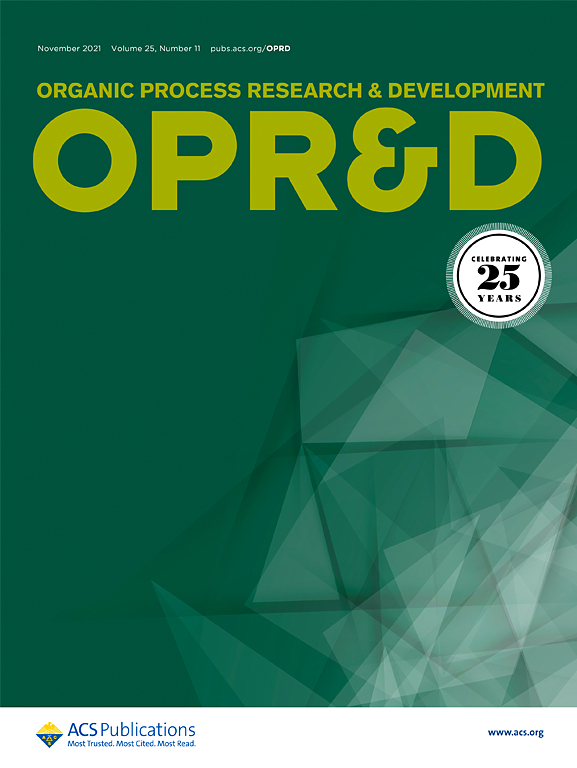Development of a Convergent and Scalable Synthetic Route to Long-Acting RSV Inhibitor JNJ-7950
IF 3.1
3区 化学
Q2 CHEMISTRY, APPLIED
引用次数: 0
Abstract
JNJ-7950 is a potent small-molecule respiratory syncytial virus (RSV) inhibitor with a long-acting profile in preclinical species. The design and development of a convergent synthetic route accelerated the discovery and development of JNJ-7950. First, the new synthetic route supported the lead candidate (JNJ-7950) selection process and later was adapted to provide a large-scale clinical batch. A shorter and cost-effective synthetic route to the key spiro-azetidine moiety exploited an intramolecular copper-catalyzed C–N coupling. The development of an efficient and sustainable process for telescoping three steps in a single solvent provided the benzimidazole moiety with an 85% overall yield. The spiro-azetidine and the benzimidazole moieties were coupled to provide JNJ-7950 in 48% overall yield with excellent purity over the six longest linear steps. Two GMP batches (6 and 12 kg) of JNJ-7950 were manufactured in parenteral grade quality to support long-acting injectable formulation development and early clinical need.

长效RSV抑制剂JNJ-7950聚合可扩展合成途径的建立
JNJ-7950是一种有效的小分子呼吸道合胞病毒(RSV)抑制剂,在临床前物种中具有长效特征。聚合合成路线的设计和开发加速了JNJ-7950的发现和开发。首先,新的合成路线支持先导候选物(JNJ-7950)的选择过程,后来被用于提供大规模的临床批量。利用分子内铜催化的C-N偶联得到了一条更短、成本更低的合成途径。开发了一种高效、可持续的在单一溶剂中伸缩三步的工艺,使苯并咪唑部分的总收率达到85%。通过六个最长的线性步骤,将螺-氮杂啶和苯并咪唑偶联得到JNJ-7950,总收率为48%,纯度高。两个GMP批次(6和12 kg)的JNJ-7950以肠外级质量生产,以支持长效注射制剂开发和早期临床需求。
本文章由计算机程序翻译,如有差异,请以英文原文为准。
求助全文
约1分钟内获得全文
求助全文
来源期刊
CiteScore
6.90
自引率
14.70%
发文量
251
审稿时长
2 months
期刊介绍:
The journal Organic Process Research & Development serves as a communication tool between industrial chemists and chemists working in universities and research institutes. As such, it reports original work from the broad field of industrial process chemistry but also presents academic results that are relevant, or potentially relevant, to industrial applications. Process chemistry is the science that enables the safe, environmentally benign and ultimately economical manufacturing of organic compounds that are required in larger amounts to help address the needs of society. Consequently, the Journal encompasses every aspect of organic chemistry, including all aspects of catalysis, synthetic methodology development and synthetic strategy exploration, but also includes aspects from analytical and solid-state chemistry and chemical engineering, such as work-up tools,process safety, or flow-chemistry. The goal of development and optimization of chemical reactions and processes is their transfer to a larger scale; original work describing such studies and the actual implementation on scale is highly relevant to the journal. However, studies on new developments from either industry, research institutes or academia that have not yet been demonstrated on scale, but where an industrial utility can be expected and where the study has addressed important prerequisites for a scale-up and has given confidence into the reliability and practicality of the chemistry, also serve the mission of OPR&D as a communication tool between the different contributors to the field.

 求助内容:
求助内容: 应助结果提醒方式:
应助结果提醒方式:


